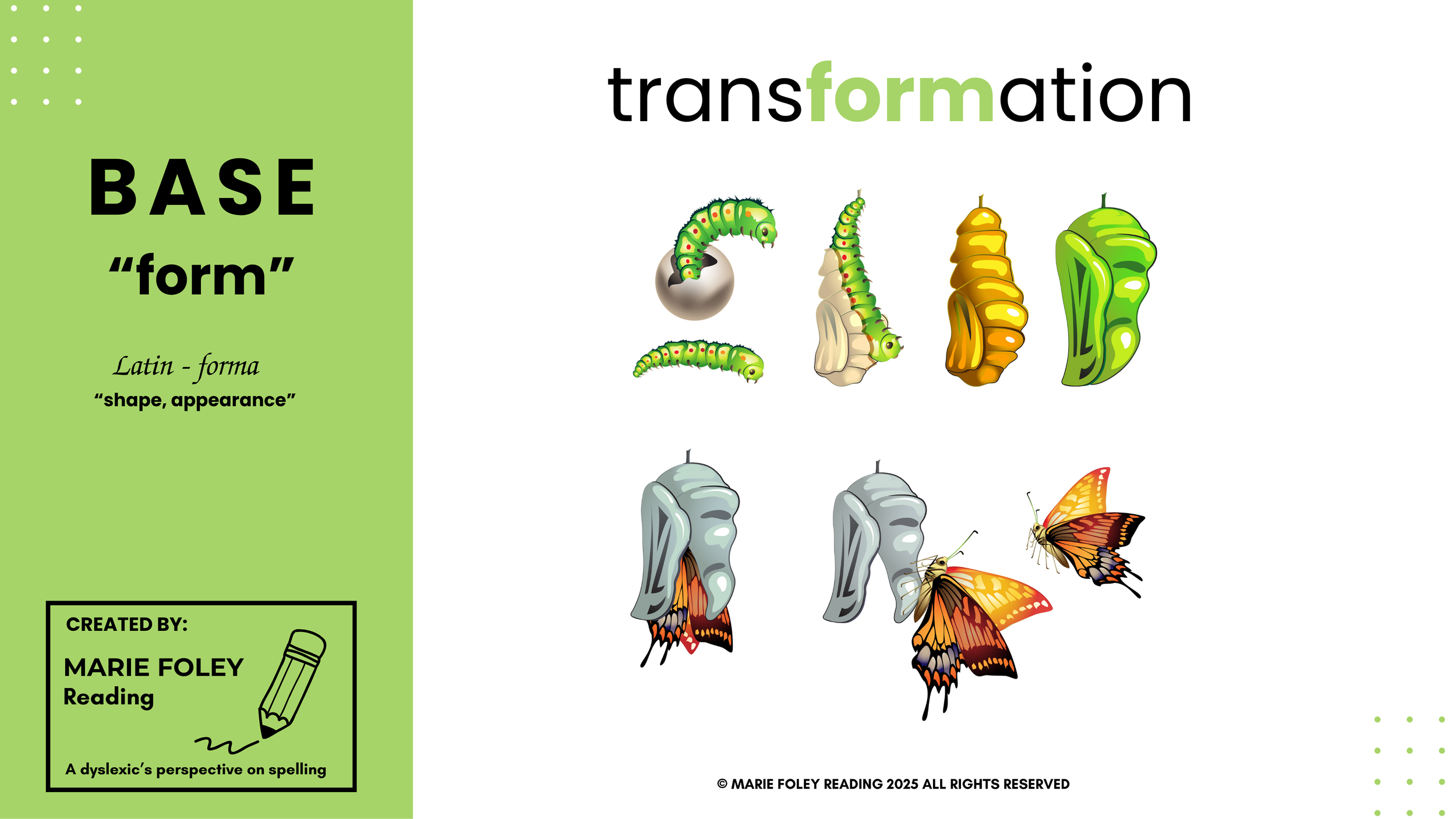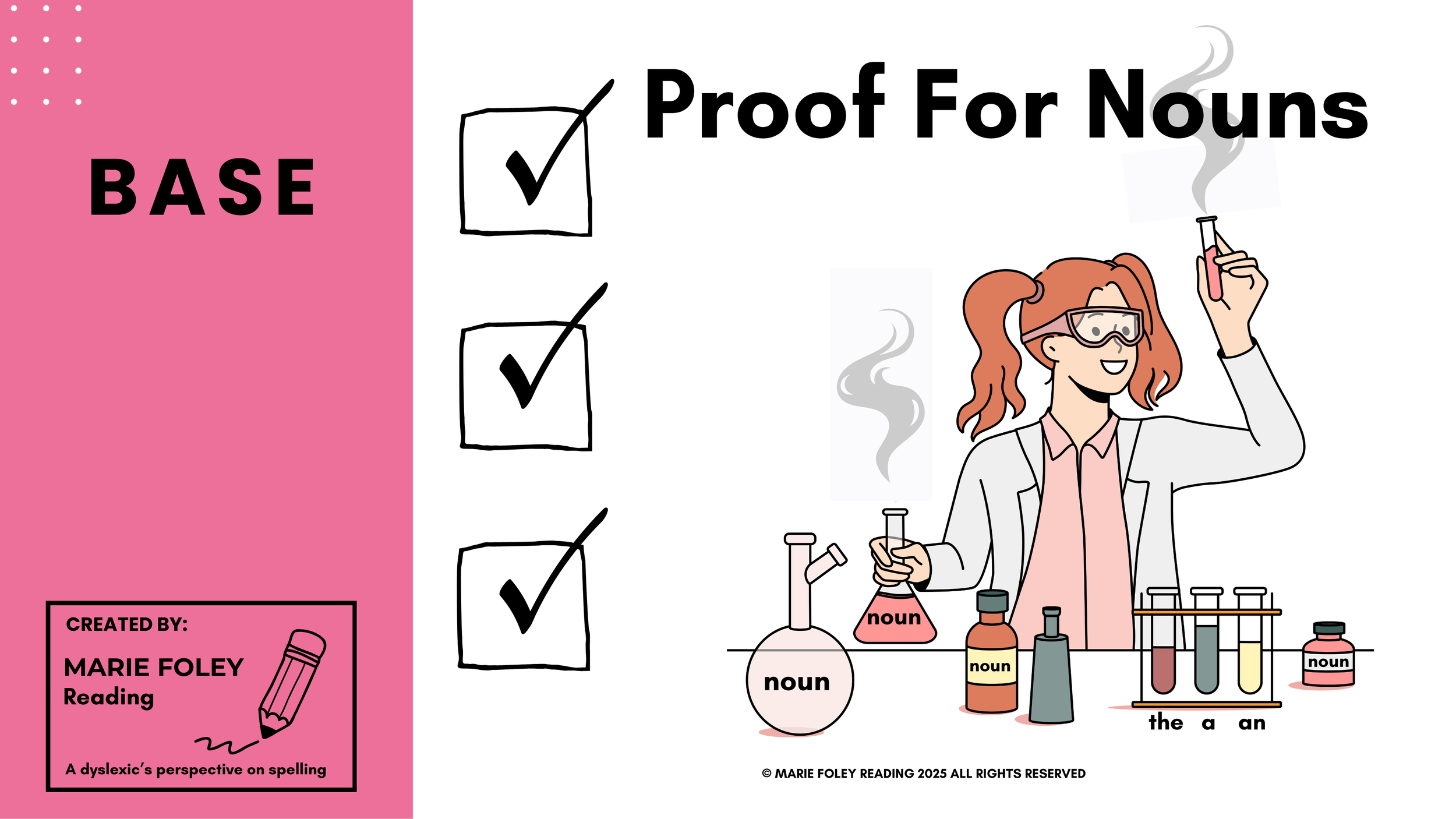Word Family: play, played, player, playful, playing, plays, and playground.
Content: How to build a word family. Notice how the <e> is not writing a pronunciation in the word played. Discover one of the jobs of suffix -er. Notice what position in the word we use the grapheme <ay>. Learn how to create compound words.

Word Family: abrupt, abruptly, corruption, disrupted, disruption, rupture, eruption, interruption and uninterrupted.
Concepts: Notice how the phonology of <t> can shift across the family. Make sense of assimilated prefixes, reduced vowels and graphemes that do not write pronunciations.

Word Family: friend, friends, friendly, friendliest.
Concepts: Notice how etymology can help students make sense of graphemes that are not writing a pronunciation. Explore how a single <y> grapheme can toggle to <i> when adding on suffixes unless the suffix begins with <i>.

Word Family: protect, protects, protection, detective.
Concepts: Notice how <t> can write different pronunciations across a word family. Discover how to build a word family. Explore how etymology reveals the core meaning of the base and how this meaning is shared across a word family.

Word Family: heal, healer, health, healthy, healthiest
Concepts: Notice how the phonology of the grapheme <ea> can shift across a word family. Discover how spelling heal with the grapheme <ea> helps to distinguish the difference in meaning between the homophones heal and heel. Explore the suffixing convention of <y> toggles to <i>.

Word Family: contractions, tractor, extract, subtract, attract.
Concepts: Explore the etymology of the word contraction to help students notice that all the words in this family have something to do with the notion of pulling. Activating this understanding helps students make sense of what contractions are in English spelling. It may also be helpful to highlight that the apostrophe signals that graphemes have been extracted.

Word Family: collected, collection, collective, collectively, select, elected.
Concepts: Noticing that <t> can write /ʃ/ when followed by an <i>. Discovering that vowels can be reduced all the way to zero. Observing that the pronunciation of the base in a word can shift across a family. Noticing how suffixes can change the potential grammatical form of words.

Word Family: insect, insects, sections, dissected, bisected, intersection
Base: <“sect” from Latin secare "cut"
Concepts: What can <t> write? Suffix dis- meaning apart. Suffix bi- meaning “two”.

Word Family: wind, winding, winds
Concepts: Noticing how the difference in pronunciation between wind and wind signals a difference in meaning.
Exploring etymological relatives wander, went and go.

Word Family: migrate and migration
Concepts: Vowel suffixes can replace a single final non-syllabic <e>. Noticing that <t> can write /ʃ/ when followed by an <i>.

Word Family: exit, transit, transitions, initial, initials, initiative.
Concepts: Notice how vowel suffixes replace the single, final, unpronounced <e>. Notice how the grapheme <t> can write different pronunciations.

Word Family: creation, creative, creature
Concepts: Vowel suffixes can replace a single final non-syllabic <e>. Noticing that <t> can write /ʃ/ when followed by an <i> and <t> can write /ʧ/ when followed by a <u>. Discovering that vowels can be reduced all the way to zero. Observing that the pronunciation of the base in a word can shift across a family.

Word Family: form, transformation, information, uniform, nonconformist
Concepts: Vowel suffixes replace a single final non-syllabic <e>. Noticing that <t> can write /ʃ/ when followed by an <i>. Discovering how etymology reveals the deeper meaning of the base and helps to uncover related words.

Word Family: press, pressed, pressure, depressed, oppressive, expression, impressive.
Base: <press> from Latin pressare "to press"
Concepts: What can <s> write? Noticing assimilated prefixes.
Word Family: clap, claps, clapping, clapped.
Concepts: Notice how vowel suffixes cause spelling changes.

Concepts: Help students identify whether or not a word is a noun using the proof for nouns. Notice how nouns can be used in sentences.

How to help students notice word structure.
How to explain vowel reduction and graphemes that are not spelling a pronunciation.
Discover how to help students build a word matrix and how to integrate it into practicing spelling words.
Explore how to help students document learning.

Concepts: The spelling of a word makes more sense when you explore related words. Discover how some graphemes have positional constraints (beginning, middle, end).
Graphemes: Notice how <ey> is the best fit for the spelling of they as it marks a connection to the <e> in them and their.

Word Family: realize, real, really, reality, realistic.
Concepts: Discover how to build a word matrix. Notice how studying related words helps students make sense of words that have reduced vowels or graphemes that are not writing a pronunciation. Explore how to visually represent vowel reduction.

Concepts: Explores the difference between alphabetic letters and graphemes. Identifies the difference between single letter graphemes, two letter graphemes and three letter graphemes.

Word Family: tooth, toothbrush, toothpaste, toothless.
Graphemes: The relationship between grapheme <oo> and <ee>.
Concepts: Vowel reduction in the suffix -less. Compound words. The function of the single unpronounced <e> on the word toothpaste. Words distantly related to teeth.

Concept: The spelling of a word make more sense when you look at related words.
Graphemes: The positional uses of <ay> word final and <ai> at the beginning and middle of a base.

Word Family: jump, jumped, jumping, jumps.
Concepts: Building a word family. Suffix -ed, ing, -s

Word Family: rain, raining, rained, rains, rainy, rainiest.
Concepts: The combining nature of alphabetic letters, graphemes, morphemes and words.

Word Family: decision, incisors, concise, precise.
Concepts: Vowel suffixes replace single, final, unpronounced <e>. Notice that the grapheme <c> and <s> can write different pronunciations.

Word Family: conserve, conservation, observe and observant.
Concepts: Vowel suffixes replace single final unpronounced <e>. Notice what the grapheme <t> can write?

Word Family: vision, revise, invisible, visit, and visual.
Concepts: Notice that vowel suffixes replace single, final, unpronounced <e>. Discover how <s> can write different pronunciations across the family.

Concepts: This video explores the spelling and meaning connection between the words here, where and there which all are related to the concept of position.

Concepts: Notice the unpronounced <l> in walk makes more sense when you examine related words. Explore how words that share a meaning often share a spelling.

Word Family: ingest, digest, digestive, congested, suggest.
Concepts: Notice how the grapheme <t> can spell different phonemes across the word family. Discover words with assimilated prefixes which can cause spelling challenges.

Concepts: Make sense of word which contain graphemes that are not writing a pronunciation by exploring related words. Notice words that share a meaning often share a spelling.

Word Family: erode and rodent.
Concepts: Notice that vowel suffixes replace single, final, unpronounced <e>. Identify words with reduced vowels which can cause spelling challenges. Discover what the grapheme <o> can write.